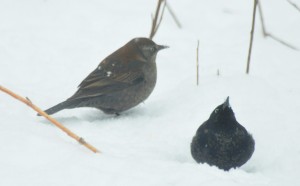Photography courtesy of Lowell Washburn, all rights reserved.
Iowa is well known for its late season, often-spectacular March snowstorms. This year proved no exception when, on March 5th and 6th, anywhere from four to seven inches of heavy, wet snow descended on the state’s northern counties.
Although the weather event didn’t exactly fit the description of an old-fashioned prairie blizzard, the snowfall was enough to effectively reduce visibility and make highway travel difficult. The two-day storm was also more than enough to get the attention of resident and migrating birdlife. By the morning of Tuesday, March 6th, North Iowa’s backyard bird feeders were jumping. At my home at Clear Lake, I observed more species and counted the greatest total number of birds of any day this winter. The fresh clean snowscape was beautiful; the backyard viewing fabulous – 18 species sighted during my first half cup of morning coffee. What a great way to start the day!
One of those visiting bird species is certainly worth mentioning. On Monday, our feeders were visited by a group of five, ground feeding rusty blackbirds. On Tuesday, the same feeders were visited by three rustys. I cannot say, of course, whether or not Tuesday’s trio were new birds or simply returnees from the previous day.
Here’s what I can say. The highly migratory, rusty blackbird is currently showing one of the most alarming declines of any North American songbird. According the National Wildlife Federation’s, Jennifer Strickland, rusty populations have dropped by more than 90 percent during the past 40 years.
Rusty blackbirds love damp habitats. Most rustys breed in the muskeg and boreal forests of far northern Canada where a dramatic loss of natural beaver ponds may have contributed to the species’ decline. Elsewhere in the north, rusty blackbirds are also exhibiting high levels of mercury contamination.
The wooded swamplands of the southeastern U.S. provide rusty populations with critical wintering habitat. Here, continued drainage and commercial logging may be leading to decreased survival of adult birds. With increased habitat loss and environmental pressures coming at them from all directions; the rusty blackbird could clearly use a break.
Although greatly reduced in number, rusty blackbirds remain widespread and currently migrate across 39 of the Lower 48 states. In an effort to obtain sorely lacking, specific migration data – where rustys go and when they go there — a Rusty Blackbird Spring Blitz Facebook Page was established during 2015 and 2016. The Blitz page collected public sightings during March and April through an eBird Checklist.
Similar in size and shape to red-wings, rusty blackbirds may be easily overlooked — especially where large gatherings of other blackbirds are present. Bright, pearl-colored eyes and rusty edged plumage are primary keys to identification. Although the exact timing will largely depend on weather, the peak of this spring’s migration through Iowa will occur during the next few weeks. If you’ve not yet observed this far flung winged traveler, this might be the year. Have an eye peeled, and don’t forget to keep the feeders filled.



 Susan Judkins Josten
Susan Judkins Josten Rudi Roeslein
Rudi Roeslein Elyssa McFarland
Elyssa McFarland Mark Langgin
Mark Langgin Adam Janke
Adam Janke Joe Henry
Joe Henry Sue Wilkinson
Sue Wilkinson Tom Cope
Tom Cope Kristin Ashenbrenner
Kristin Ashenbrenner Joe Wilkinson
Joe Wilkinson Dr. Tammy Mildenstein
Dr. Tammy Mildenstein Sean McMahon
Sean McMahon